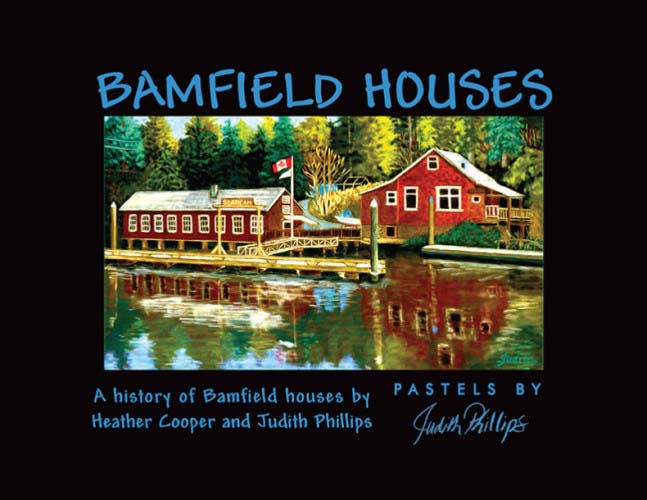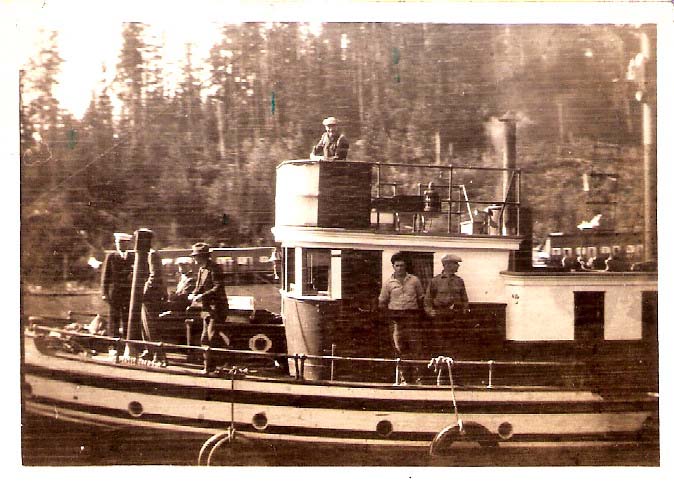Cohoe Lodge and the Uyede
Family at Bamfield
 Pastel by Judith Phillips "This structure was built by the Uyede family, who came to Canada from Japan in 1898 from many generations of fishermen. Arriving in Bamfield from Steveston, Densaburu and his son Ichiaro or Henry (also known to some of the locals as Ichi) worked at the local cannery. When Densaburu died in 1928, Ichiaro took over the family fishing boat, Knight II, and quickly gained a reputation for himself as one of the best highliners on the west coast. It was while unloading his catch at the Kildonan cannery that he met his wife, and she and her mother moved with him into the house he built in Bamfield. The couple’s first child, a girl, was born in the house. By the time he was 30, Ichiaro had achieved great success in life, owning the house, the Knight II and part of another boat … “Sadly, the Uyede family was forced out of Bamfield when they were declared enemy aliens and sent to a series of internment camps… Ichiaro, being a man of foresight, was fortunate in selling his house and boat to neighbours. All of their other possessions, with the exception of one trunk and its contents, were taken from them by the government. A peculiar footnote to this story was told by John Vanden and several other people who were living here at the time, and confirmed, according to Marc Phillips, by family member Michiko Sing. When the Japanese bombed Pearl Harbor, Ichiaro is said to have painted Japanese characters on the roof of his house which said ‘Don’t bomb me, I’m Japanese.’ Apparently the RCMP made him paint it out.” – Bamfield Houses, by Heather Cooper and Judith Phillips  -------------------  From Tak Uyede, 2017: Trollers would drift or anchor on the Big Bank or La Perouse bank overnight to save time and fuel going back to harbour. The Packers would sell ice and sometimes groceries and buy the salmon catch and when fully laden, make the run into Steveston. I think the ship belonged to Canfisco, Canadian Fishing Company, where my father became an indentured fisherman when we arrived back on the coast with no money and no boat with which to earn a living. Anyways, when this ship arrived in Bamfield [in 1942] with all the men of Ucluelet already loaded in the hold, my father refused to go below [as it was] still redolent with the stench of fish. Being one of the few at that time who were fluent in English, he declared to the RCMP officer that the only way he was going to go below was dead on a plank. He translated this message to those already below in Japanese, whereupon all of the men, one by one, clambered out of the hold with their hands in the air. They then completed the trip on deck where they could wave goodbye to their families on the dock and watch their homes recede into the wake. I doubt that anyone could imagine that it would be another fifteen years before they would breathe the salt air. My sister who would have been only six at that time often recounted this story and the skipper of the ship, a Mr. "Red" Ossinger, would speak of that moment many years later when our family moved back to Port Albion in 1957 where the Ossinger and Uyede families became neighbours again. While my mom and my sisters lived in the PNE stables, my dad was sent to Brookmere, just off the Coq. past the Othello tunnels. My father was recruited to work in Tashme to oversee(?) help build the internment shacks where the family was reunited. Oddly enough, we have rented a chalet in Sunshine Village/aka Tashme this winter for a few days. Some family members are aghast at the idea. My sister will be coming along and it will be interesting to see exactly how she will respond to her memories. Our family moved from Tashme to Lac du Bonnet (north of Winnipeg) and from there to a tiny village called Tionaga (near Foliet/Timmins) in Northern Ontario. A number of JC families moved there to work in a planer mill but the mill burned and times were pretty tough. Northern Ontario winters were not anything that coast families were prepared for and by Christmas day, every stick of firewood was already burned and the men were forced out in -50 f., to try to cut firewood with almost no winter clothes. Pike, pickerel, trout, and moose meat kept the family fed. There was always a huge garden as well. The family also ran a grocery, mail office, and laundry until 1957 when we came back to the coast. Born in 1948, I have few memories of that time except that one time I was at the siding when a train was stopped for water and the train engineer showered us with candy bars. It took me years to figure out why they were so generous. That and when I was about five or so, the government looked after our dental needs by sending a vet in a caboose which parked in a siding and extracted all my rotted teeth without benefit of anaesthetic. I did not see another dentist until I was in my late teens, so traumatized I was by that. As a child I was oblivious to our position and was shocked to discover that I was ever in an internment camp. When my sisters asked me what I was thinking, I replied "There was no barbed wire so how could it be confined?" They replied that when the government sticks you 300 miles from anywhere, they don't need barbed wire to keep you in … |
